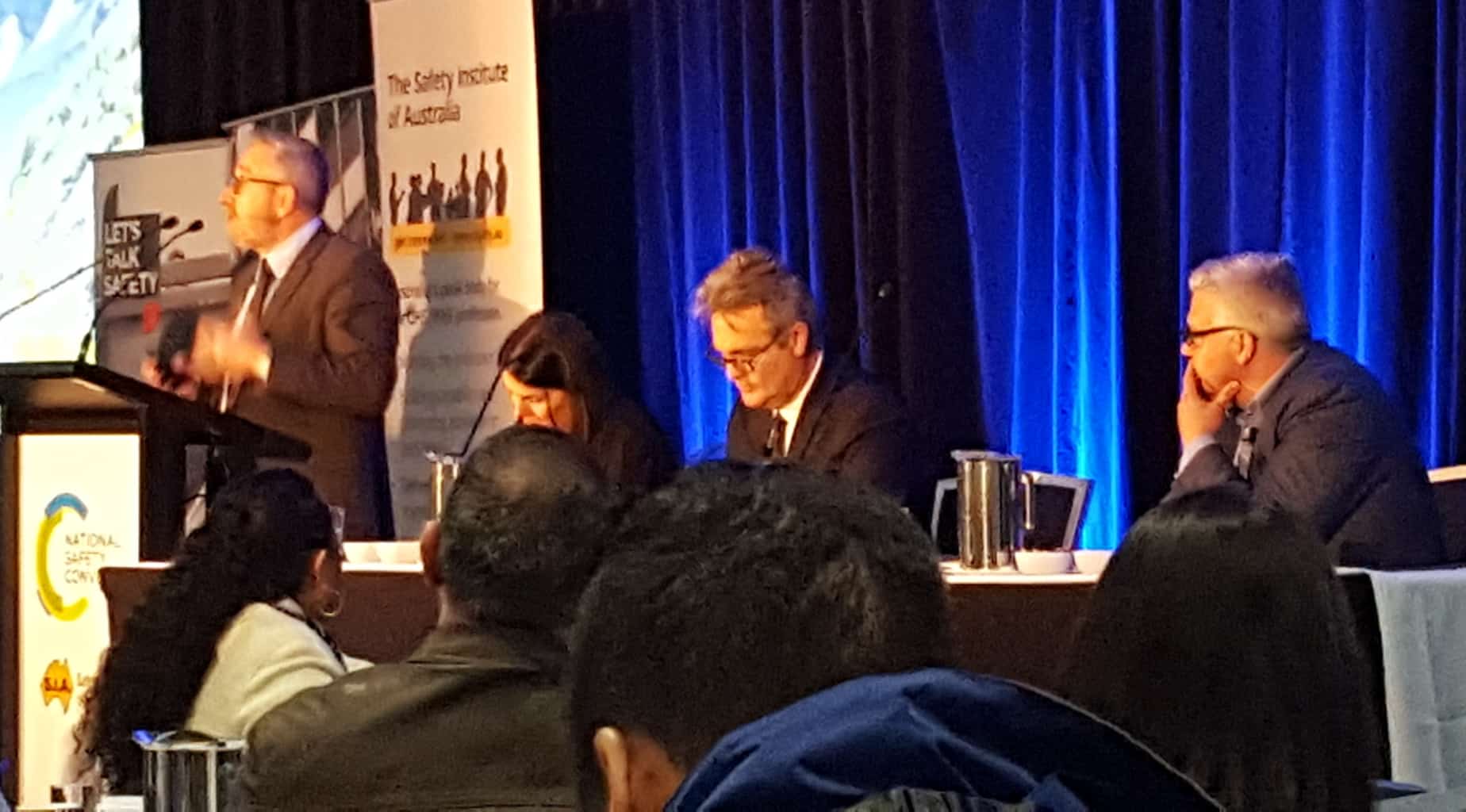Subscribers will know that I often make connections with ideas from beyond the traditional occupational health and safety (OHS) areas. The other day I was travelling back from a regional part of Victoria, listening to All Things Considered. There was an article about regaining and maintaining a sense of wonder. I found some wonderful OHS stuff.
Category: imagination
Safety disruption gets context
The second session of the SIA National Convention is flatter than the the first, not because it is not interesting but because it is providing us with the social context for occupational health and safety (OHS) rather than challenging the OHS profession.
Bernard Salt is a very high profile demographer whose job is almost entirely about providing social context to whatever we do. He mentioned OHS specifically only four times and then primarily to do with driving trucks but the age data Salt presented shows the need for improvement in the health and wellbeing of the workforce so that quality of life can extend in line with the extended period of our lives.
 Peter Gahan (pictured right, speaking)of the Centre of Workplace Leadership is a regular speaker at the Safety Institute of Australia’s conferences. His outline reflects the theme of this conference by disrupting our sense of security and career.
Peter Gahan (pictured right, speaking)of the Centre of Workplace Leadership is a regular speaker at the Safety Institute of Australia’s conferences. His outline reflects the theme of this conference by disrupting our sense of security and career.
The challenge comes from how we respond to this unease. If we curl up on the couch to binge watch a show, the career is over. We need to look for the opportunities that the disruption offers but this may require us to reassess, if not throw out, the foundations of our profession or the dreams on which we chose our career.
Richard Coleman is well known in the Australian OHS profession through his prominent safety career. His attraction as a conference speaker was on display because he was able to adjust his presentation to accommodate the examples and context that previous speakers addressed. Coleman focused on the digital disruption, particularly as it affects blue collar occupations. He believes that some of these jobs will go within the next five years.
Coleman’s focus on digital disruption provided a great summary of the OHS application of augmented reality and wearable technology. The latter has the best opportunity for safety improvement, particularly in the area of manual handling. Sensor technology can provide better levels of information and in real time that allows immediate interventions at times of great risk.
What these speakers and the panel are all about is to think creatively and think big. Fantasise about your job and the tasks you do now and whether they will exist in ten years and how you can change them now to prepare for the future. If your job leads to a dead-end, change the job. It seems easier to do this now, than ever before
Don’t kill anyone. Don’t seriously injure anyone.
 Michael Tooma (pictured right) has been a leading writer on occupational health and safety (OHS) law in Australia for some time. He is one of the few labour lawyers who is not afraid to express an opinion although he has always spoken within the legal context.
Michael Tooma (pictured right) has been a leading writer on occupational health and safety (OHS) law in Australia for some time. He is one of the few labour lawyers who is not afraid to express an opinion although he has always spoken within the legal context.
Recently Tooma participated in a roadshow with
Dead Men Tell No Tales – Safety Storytelling
A common theme throughout presentations at the Safety Asia Summit in Kuala Lumpur was the need to communicate safety and health clearly and concisely to variety of nationalities with a variety of literacy levels. My presentation aimed at reminding the OHS professional delegates that they may already have skills that they could use in communicating safety issues to their audience or workers and contractors.
Every culture has stories. Stories have been the dominant way of teaching for centuries but we are gradually losing some of our innate storytelling skills or we do not see how they may be relevant to the workplace. OHS professionals could benefit from redeveloping those skills and also encouraging those skills in others. Stories can be a base for teaching,listening and, in OHS parlance, consultation.
The story
Quite often people in business talk about “the story” without really appreciating the complexity of storytelling, or the power of storytelling. Here are two quotes about stories that I plucked from a marketing brochure:
“The story is what drives the bond between the company and the consumer.”
“Stories can be used to communicate visions and values, to strengthen company culture, to manage the company through change and to share knowledge across the organisation.”*
There is some truth in these quotes but the purpose of the quotes undermine their value. The book these are from discusses storytelling in terms of branding and advertising, in other words the purposeful manipulation of people’s desires. For marketing and advertising is the sector where storytelling has been most effective in supporting the selling of products and the selling of ideas.
Continue reading “Dead Men Tell No Tales – Safety Storytelling”
Truly acknowledging failure provides a strong base for improvement
When one fails in safety management, people can get hurt or die, yet safety professionals and business executives rarely acknowledge this failure, even though companies may plead guilty in court. Instead “mistakes” are made, “deficiencies” are identified and investigations uncover “areas for improvement” but these are rarely described as “failures”.
October 13 was the International Day For Failure (IDFF), a day that is intended to provide a structure for the discussion of failure and how we respond to, and cope with, failure. The quote that most summarises the day is
“Failure is not the enemy, the fear of failure is”.
Part of the impediment for growth in safety management is that people are encouraged to deny liability for their actions. Executives receive legal advice to say as little as possible and to keep as much as possible under legal-client privilege. This is anathema to the principles of safety management that require failures to be acknowledged and for new preventive strategies to be developed. Yes, shit happens but safety management is particularly required to not let the shit happen twice. Continue reading “Truly acknowledging failure provides a strong base for improvement”
Australian OHS awards need reviewing now more than ever
The various government safety awards process in Australia needs a thorough coordinated review in order to maintain their relevance. Earlier last year WorkSafe Victoria tried a new strategy to increase community participation in their awards process. This involved monthly mini-awards and nominees calling on their friends and professional networks for support and votes. It was worth a try but WorkSafe Victoria went it alone and it will be difficult to sustain this strategy without broader support, probably from the other States.
SafetyAtWorkBlog stated following last year’s national safety awards ceremony that change was required but no one took up the challenge. The need for review was even more evident at this year’s Safe Work Australia Awards held last week. The lacklustre atmosphere could have been partly due to an MC, Paul McDermott, who is more comfortable piercing the pretensions of institutions. In these awards, it would have been rude to make fun of workplace safety. McDermott understood this and could only make jokes of his own brushes with danger, such as having his scrotum pierced with a winklepinker. But it is more likely that the awards had more serious deficiencies. Continue reading “Australian OHS awards need reviewing now more than ever”
The Asphyxiation of OHS
Good OHS thinking and practice are being slowly asphyxiated. By far most suggestions by workers, unions or good consultants for Health & Safety improvements are ‘choked’ by management naysayers and bureaucrats more in touch with their current minister’s moods than workplace reality. Not choked immediately or blatantly. In fact, that person may be patted on the back and encouraged to raise more OHS matters, “Yes, mate, good! Tell us what else we’re doing wrong, very very helpful. You just keep on telling us”…….. And slowly any significant discussion about OHS problems is suppressed and killed.
 The majority of workers in Australia work in small workplaces where (typically) practical OHS programs are regarded by managers as a nuisance, a bit of ‘over-the-top’ nonsense that slows down productivity. It’s regarded as an irritant of fashion that will pass, like the fashion-related, politically correct things to say. Continue reading “The Asphyxiation of OHS”
The majority of workers in Australia work in small workplaces where (typically) practical OHS programs are regarded by managers as a nuisance, a bit of ‘over-the-top’ nonsense that slows down productivity. It’s regarded as an irritant of fashion that will pass, like the fashion-related, politically correct things to say. Continue reading “The Asphyxiation of OHS”

